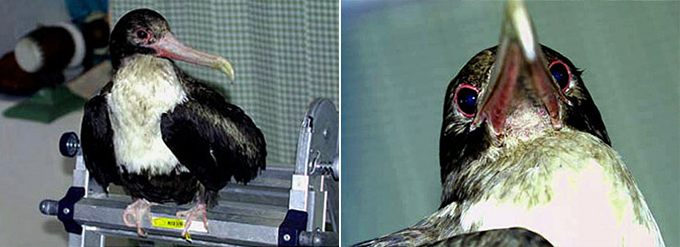As a result of typhoon Maegi, a frigatebird was picked up exhausted from a sea breakwater on Jeju Island on August 19th, and taken into care. It has subsequently recovered and was identified by Kang Chang-Wan. Coming only 10 days after a Lesser Frigatebird Fregata ariel was photographed on Socheong Island ca 500 km to the north, the Jeju bird was identified as a Great Frigatebird Fregata minor, a species previously unrecorded in Korea.
(It is worth noting that KANG Chang Wan also provided news of a Bonin Petrel Pterodroma hypoleuca, found dead on a road in Jeju on August 15th. This is possibly only the second record of the species in South Korea (with the first record, one caught in a fishing net and rescued at Banghwa Dong Gangseo Gu Seoul on 6th Aug 1999 (after a typhoon), described by Lee, Woon and Kim in the Korean Journal of Ornithology: 6: 133-134).)

Following correspondence between Birds Korea and frigatebird expert David James (the second time in only a week that David has lent his expertise to ageing frigatebirds found in Korean waters!) the bird has now been confirmed to be a non-adult female Great.
David's comments are summarised thus:
"This frigatebird is indeed a Great Frigatebird, either a 4th or 5th year female. The colourful bill and orbital ring indicate a female. The smudgy (not black) throat is diagnostic of female Great. The remnant buff feathers on the forehead probably indicate the bird is not quite mature, so in its fourth year. It could come from the wide -spread Indian Ocean subspecies (nominate minor) which always shows a red orbital and pink bill (Paracels, Gunung Api in the Banda Sea and Cocos Keeling Is are the nearest populations to Korea) or the North Pacific subspecies (strumosa*) which always has a red orbital ring but can have a pink or blue bill (probably the Caroline or Marshal Is are the closest to Korea but Central Pacific birds are known to wander to Eastern Asia)."
Recorded as an "uncommon visitor in the Pacific north to the Ogaswara and Iwo Islands" in neighboring Japan, even occurring very rarely as far north as Hokkaido according to Brazil (1991), this well-documented individual is the first known record of the species in South Korea and on the Korean peninsula, and is now admitted to category 1 of the WBKE Unofficial checklist.
(Birds Korea is very grateful for permission from KANG Chang Wan to post his images).
*NB: Axel Braunlich has pointed out that in the revised and enlarged 3rd Edition of Howard and Moore's Complete Checklist of the Birds of the World. (Dickinson, E. C., ed. 2003.) strumosa is included in F. minor palmerstoni.



